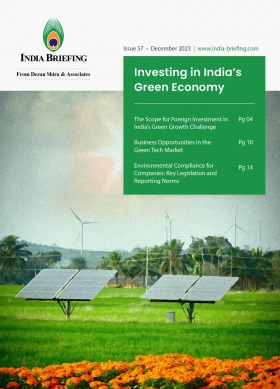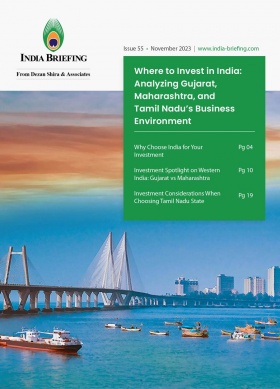India’s Interim Budget 2024: No Populist Measures, No Changes to Taxation
India’s interim budget 2024, which is a vote on account, was presented on February 1, and contained no major policy changes or revisions to the taxation structure. We round up the key sectoral provisions laid out in the budget and the fiscal data provided by Finance Minister Nirmala Sitharaman.
India’s Union Finance Minister Nirmala Sitharaman unveiled the much-anticipated interim budget as scheduled on February 1, with key announcements for selected sectors. The overall mood of this budget announcement was a statement of progress, comparing the Indian economy’s performance over the last 10 years – under two consecutive terms of the Narendra Modi government. The budget speech was among the shortest in recent years.
The sitting Modi government appears confident of its position ahead of the general elections, and a ‘broader roadmap’ will be discussed in July after a new government is sworn in. This explains why Sitharaman did not introduce any significant new spending programs or expansion of schemes that could be categorized as populist measures.
State of the economy: Fiscal report card
- The Revised Estimates indicates that India’s fiscal deficit stands at 5.8 percent of the gross domestic product (GDP).
- For the fiscal year 2024-25, total estimated receipts, excluding borrowings, are projected at INR 30.80 trillion (US$371.19 billion), while total expenditure is estimated at INR 47.66 trillion (US$619.58 billion). Tax receipts are expected to reach INR 26.02 trillion (US$338.26 billion). The 50-year interest-free loan scheme for capital expenditure to states continues this year, with a total outlay of INR 1.3 trillion (US$16.9 billion ).
- The commitment to fiscal consolidation, as outlined in the Budget Speech for 2021-22, remains steadfast, according to Sitharaman, aiming to reduce the fiscal deficit to below 4.5 percent by 2025-26. The projected fiscal deficit for 2024-25 is 5.1 percent of GDP, aligning with this trajectory.
- Anticipated gross and net market borrowings through dated securities during 2024-25 are INR 14.13 trillion (US$183.69 billion) and INR 11.75 trillion (US$152.75 billion), respectively, both lower than the figures for 2023-24. With significant private investments expected, the reduced borrowings by the central government are poised to improve credit availability for the private sector.
Key provisions of Interim Budget 2024
Below we list some of the key provisions of the interim budget, which is a Vote on Account.
The Vote on Account, outlined in Article 116 of the Indian Constitution, allows the government to access funds from the Consolidated Fund of India temporarily, usually for a few months, to cover essential expenses until a full budget is approved. This provision is crucial during transitional periods, such as before general elections, when the existing government might be in a caretaker role, limiting its ability to implement new policies or budgetary measures. The Vote on Account ensures the continuity of government operations by sustaining routine expenditures until a new government takes office.
Direct tax
In her second interim budget speech, the finance minister announced the government’s decision to withdraw old, petty, non-verified, non-reconciled, or disputed outstanding ‘Direct Tax Demand’. This move is said to provide relief to over 10 million taxpayers in the country, along with ensuring ease of living and ease of doing business.
Sitharaman did not make any changes relating to taxation and proposed to retain the same tax rates for direct taxes and indirect taxes, including import duties. However, she disclosed that tax benefits for start-ups and investments by sovereign wealth or pension funds, along with tax exemptions for certain income of specific IFSC units, would be extended until March 31, 2025.
Major tax-related outcomes from the interim budget
Start-ups and investment incentives:
- Tax benefits for start-ups and investments by sovereign wealth funds and pension funds have been extended to March 31, 2025.
- Tax exemptions for certain International Financial Services Center (IFSC) units, due to expire on March 31, 2024, are now extended to March 31, 2025.
Corporate tax rates:
- Existing domestic companies to continue at a 22 percent corporate tax rate.
- New manufacturing companies are eligible for a reduced tax rate of 15 percent. However, tax experts have noted that the interim budget documents do not indicate an extension of the applicability of Section 115BAB of the Income-tax Act, 1961. This section offers a favorable tax rate of 15 percent to companies incorporated after 2019 and commencing their manufacturing activities before March 31, 2024.
Direct tax demand withdrawals:
- Outstanding direct tax demands up to INR 25,000 for the fiscal years up to FY 2009-10 will be withdrawn.
- Demands up to INR 10,000 for fiscal years FY 2010-11 to FY 2014-15 will also be withdrawn.
- This measure is expected to benefit around 10 million taxpayers.
Personal income tax:
- Under the new tax regime, individuals with an income up to INR 700,000 are exempt from tax liability.
Electric vehicles
In her reading of the budget, Sitharaman stated that the Government of India aims to expand the country’s electric vehicle (EV) charging infrastructure and enhance entrepreneurship opportunities within the sector.
In FY 2024-25, a significant number of vendors will be authorized for the supply and installation of EV charging points nationwide. This initiative is expected to encourage the adoption of EVs, instill confidence in prospective buyers, and create substantial employment opportunities, particularly for youth with technical skills in large-scale manufacturing and deployment of EV charging infrastructure, as well as semi-skilled labor for maintenance tasks.
Healthcare
- The government is extending the Ayushman Bharat-Pradhan Mantri Jan Arogya Yojana (AB-PMJAY), a health insurance scheme for the poor. In the interim budget, Sitharaman announced that the scheme will now cover all ASHA workers, Anganwadi workers, and helpers.
- The finance minister announced the government’s intention to establish additional medical colleges by leveraging existing hospital infrastructure. A committee will be formed to assess pertinent issues and offer recommendations in this regard.
- In a move aimed at advancing women’s health, the government will promote vaccination among girls aged 9 to 14 years to prevent cervical cancer.
- Furthermore, the finance minister unveiled plans to upgrade Anganwadi centers under “Saksham Anganwadi and Poshan 2.0” to enhance nutrition delivery and early childhood care and development, thus bolstering maternal care initiatives.
- Additionally, a newly designed U-WIN platform for immunization management and intensified efforts of ‘Mission Indradhanush’ will be swiftly implemented nationwide.
Blue economy
In a bid to foster climate-resilient practices for a Blue Economy 2.0, the finance minister unveiled the launch of a new scheme aimed at restoration and adaptation measures as well as expansion of coastal aquaculture and mariculture. This initiative adopts an integrated, multi-sectoral approach to enhance sustainability in coastal areas.
Fisheries industry
The central government will set up five integrated aqua parks across the country. Moreover, the existing Pradhan Mantri Matsya Sampada Yojana (PMMSY) scheme will undergo amendments to boost aquaculture productivity from the current three to five tons per hectare. The overarching goal also entails doubling the export volume to INR 1 trillion and creating employment opportunities for 5.5 million individuals in the near term.
Green economy
In the realm of promoting renewable energy for housing, Sitharaman has revealed plans for rooftop solarization, enabling 10 million households to receive up to 300 units of electricity monthly. The minister anticipates this initiative will result in annual savings ranging from INR 15,000 to INR 18,000, considering the acquisition of free electricity and surplus sales to distribution companies. Additionally, she affirmed the government’s commitment to offering entrepreneurial opportunities to numerous vendors for the supply and installation of rooftop solar systems.
India has committed to achieving net zero carbon emission by the year 2070, and to achieve the same, the finance minister has announced the following measures:
- Viability gap funding will be provided for harnessing offshore wind energy potential for initial capacity of one giga-watt.
- Coal gasification and liquefaction capacity of 100 MT will be set up by 2030. This will also help in reducing imports of natural gas, methanol, and ammonia.
- Phased mandatory blending of compressed biogas (CBG) in compressed natural gas (CNG) for transport and piped natural gas (PNG) for domestic purposes will be mandated.
- Financial assistance will be provided for procurement of biomass aggregation machinery to support collection.
For promoting green growth, a new scheme of bio-manufacturing and bio-foundry will be launched. It is expected to provide environment-friendly alternatives, such as biodegradable polymers, bio-plastics, bio-pharmaceuticals and bio-agri-inputs.
Economic Railway Corridor Program
In a significant interim budget announcement, Sitharaman unveiled plans for the implementation of three key economic railway corridor programs:
- Energy, minerals, and cement corridor
- Port connectivity corridor
- High traffic density corridor
These projects are part of the existing PM Gati Shakti initiative, aimed at fostering multi-modal connectivity. They are anticipated to enhance logistics efficiency and reduce costs effectively.
Together, with the dedicated freight corridor, these three economic corridors programme will accelerate GDP growth and reduce logistics cost besides improving operations of passenger trains. – FM Sitharaman
Housing
The government has announced its decision to take up 20 million more houses under PM Awas Yojana (Grameen or rural).
Despite the challenges due to COVID, implementation of PM Awas Yojana Gramin (Rural) continued and we are close to achieving the target of 3 crore houses. 2 crore more houses will be taken up in the next 5 years to meet the requirement arising from increase in the number of families. – FM Sitharaman
Recognizing the need for affordable housing for the middle-class and below middle-class population, the government will also launch a scheme to help people living in rented houses, slums, chawls, and unauthorized colonies to buy or build their own houses.
Projects to focus on developing eastern India
Sitharaman highlighted the government’s commitment to accelerating the development of aspirational districts and blocks across states, aiming to generate abundant economic opportunities. She emphasized the government’s dedication to making the eastern region and its populace significant drivers of India’s growth.
Tourism
The government is urging states to undertake the comprehensive development of iconic tourist destinations, promoting and marketing them on a global scale. A rating framework based on the quality of facilities and services will be established for these centers. Long-term interest-free loans will be extended to states, matching their financing for such development projects.
To cater to the growing interest in domestic tourism, initiatives for port connectivity, tourism infrastructure, and amenities will be initiated on Indian islands like Lakshadweep. This endeavor is anticipated to create significant employment opportunities.
Aviation
Agri economy
Agriculture/fertilizers
After the adoption of Nano Urea, Sitharaman announced that application of Nano DAP (nano Diammonium phosphate fertilizers) on various crops will be expanded in all agro-climatic zones.
Atmanirbhar Oil Seeds Abhiyan
The finance minister announced plans to develop a strategy aimed at achieving ‘atmanirbharta’ (self-reliance) in oil seeds like mustard, groundnut, sesame, soybean, and sunflower. This strategy will cover research for high-yielding varieties, the widespread adoption of modern farming techniques, establishment of market linkages, procurement mechanisms, value addition initiatives, and crop insurance coverage.
Dairy development
The union minister at the interim budget announced that a comprehensive program for supporting dairy farmers will be formulated. Acknowledging India’s status as the world’s largest milk producer, Sitharaman noted that milch-animal (animals that produce milk) productivity remains low. The government’s proposed dairy program will leverage existing schemes like the Rashtriya Gokul Mission, National Livestock Mission, and Infrastructure Development Funds for dairy processing and animal husbandry.
Summary
About Us
India Briefing is produced by Dezan Shira & Associates. The firm assists foreign investors throughout Asia from offices across the world, including in Delhi and Mumbai. Readers may write to india@dezshira.com for more support on doing business in India.
We also maintain offices or have alliance partners assisting foreign investors in Indonesia, Singapore, Vietnam, Philippines, Malaysia, Thailand, Bangladesh, Italy, Germany, and the United States.
- Previous Article India Cuts Import Duty on Mobile Phone Components from 15% to 10%
- Next Article Interim Budget Rounds Up Key Tax Reforms, Makes Case for Modi Re-Election









